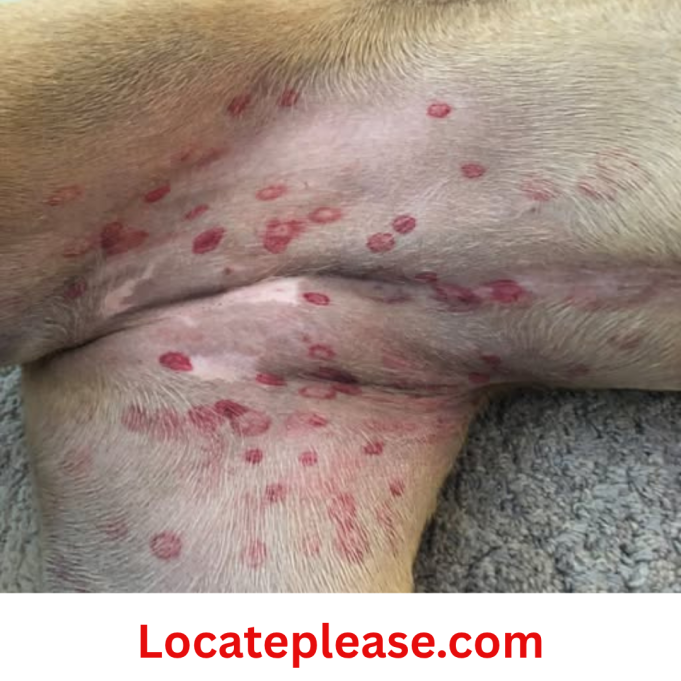If you’ve ever looked down at your dog lounging in the yard and noticed strange red, circular marks on their belly, your first instinct might be to panic. Could it be an allergic reaction? A rash? Fleas? Ringworm?
You’re not alone—and according to veterinarians, those alarming-looking spots may not be cause for alarm after all.
A reassuring message from Morinville Veterinary Clinic in Alberta, Canada, has been making the rounds online—and bringing peace of mind to countless pet owners across the globe.
🐾 What Are Those Mysterious Red Bites?
In a now-viral Facebook post originally shared on May 25, 2020, the clinic addressed a sudden wave of concerned calls:
“We are getting more and more phone calls about red bites on your dog’s stomach.”
The good news?
Those angry-looking red circles—often appearing in clusters on a dog’s lower belly or inner thighs—are likely not dangerous.
They’re most likely fly bites.
Yes—common flies, active in the spring and early summer, can land on dogs while they lie in grass and deliver tiny, irritating bites. These insects are attracted to warm, low-lying areas, and a dog’s soft underbelly is an easy target.
🔍 What Do Fly Bites Look Like?
Fly bites typically appear as:
- Small, round, red welts
- Slightly raised and sometimes with a central pinpoint mark
- Found mostly on the belly, groin, or legs—areas close to the ground when resting
- Often symmetrical or in groups
Despite their dramatic appearance, most dogs don’t seem bothered by them. There’s usually no scratching, licking, or signs of pain.
✅ What You Should Know
The Morinville Veterinary Clinic emphasized three key points:
- They look worse than they are
While the bites may appear inflamed or even infected, they’re generally superficial and harmless. - No treatment is needed
In most cases, fly bites heal on their own within a few days to a week. No ointments, antihistamines, or vet visits required—unless your dog shows signs of discomfort. - They’re seasonal
These flies tend to show up for just a few weeks each spring, then disappear as temperatures rise and conditions change.
“These flies are usually around for a few weeks every spring and then go away. We hope this eases any worry that you may have had about your own dog!”
— Morinville Veterinary Clinic
🛑 When Should You Call the Vet?
While fly bites are usually nothing to worry about, there are times when red marks do need medical attention.
Contact your veterinarian if your dog:
- Is excessively licking, scratching, or biting at the area
- Shows signs of pain, swelling, or oozing sores
- Develops hair loss, scabs, or spreading rashes
- Has fever, lethargy, or other systemic symptoms
These could indicate:
- Allergic dermatitis
- Flea allergy
- Tick-borne illness
- Bacterial or fungal infection
- Autoimmune skin disorder
When in doubt, a quick photo consult with your vet can help rule out serious issues.
🛡️ How to Help Prevent Fly Bites
While you can’t eliminate all exposure, these tips can reduce your dog’s risk:
- Avoid letting your dog lie in tall grass during peak fly season (typically late spring).
- Use pet-safe insect repellents designed for flies (ask your vet for recommendations).
- Keep outdoor time supervised during dawn and dusk when insects are most active.
- Wipe your dog’s belly with a damp cloth after outdoor play to remove irritants.
Note: Never use human bug sprays containing DEET on pets—it can be toxic.
💬 Why This Message Went Viral
The clinic’s post struck a chord because it did something rare in today’s world:
It reduced anxiety instead of fueling it.
Pet owners everywhere shared their relief:
“I was about to book an emergency appointment—this saved me $200!”
“My dog had these last year. I thought he rolled in poison ivy!”
“So glad someone finally explained this. I felt crazy thinking it was normal!”
It also highlights a growing trend: vets using social media to educate, reassure, and prevent unnecessary stress—and costs—for pet families.
🐶 Final Thoughts: Trust Your Gut—But Don’t Skip the Facts
As much as we love our dogs, it’s easy to overreact when we see something unfamiliar on their skin. But thanks to clinics like Morinville Veterinary, pet parents now have a clearer understanding of what’s truly urgent—and what’s just a seasonal nuisance.
So next time you spot those mysterious red rings on your pup’s tummy:
- Take a breath.
- Check for signs of discomfort.
- Snap a photo.
- And remember: sometimes, nature just leaves a temporary mark.
Because in most cases…
those red bites aren’t a crisis.
They’re just a sign that spring has arrived—and your dog enjoyed a nap in the grass.
🌞 And really, isn’t that what puppyhood is all about?










